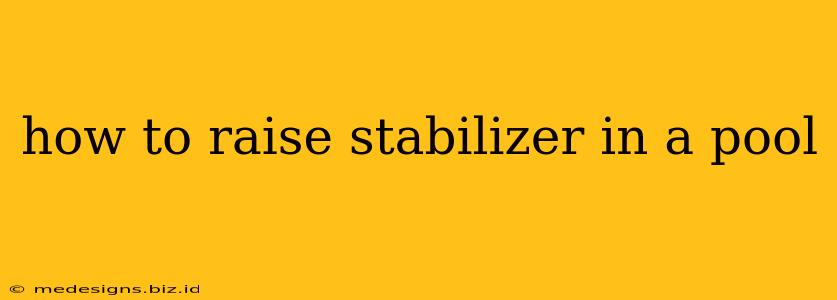Maintaining the proper chemical balance in your swimming pool is crucial for clear, sparkling water and a safe swimming experience. One key component often overlooked is stabilizer, also known as cyanuric acid (CYA). This article will guide you through understanding why stabilizer is important and how to safely raise its level in your pool.
Understanding Pool Stabilizer (Cyanuric Acid)
Cyanuric acid acts as a sunscreen for your chlorine, protecting it from the damaging effects of sunlight. Without sufficient stabilizer, your chlorine will quickly break down, leaving your pool vulnerable to algae growth and other contaminants. A low stabilizer level means you'll need to add significantly more chlorine to maintain sanitation, ultimately costing you more money and potentially harming your pool's surfaces.
Why is a low stabilizer level bad?
- Increased chlorine consumption: Sunlight rapidly degrades chlorine without sufficient CYA.
- Algae blooms: Insufficient chlorine, caused by low stabilizer, allows algae to thrive.
- Chlorine smell and irritation: High chlorine levels (often a result of compensating for low CYA) can cause strong odors and skin/eye irritation.
- Equipment damage: High chlorine levels can damage pool equipment.
Testing Your Pool Water
Before you add anything to your pool, you must test your water. Use a reliable test kit—test strips are convenient but less accurate than liquid test kits. You need to know your current stabilizer level to determine how much to add.
What is the ideal stabilizer level?
The ideal range for cyanuric acid is typically between 30-50 ppm (parts per million). Levels below 30 ppm are too low and need to be increased; levels above 50 ppm are too high and should be reduced (this usually involves partial draining and refilling).
How to Raise Your Pool Stabilizer
Once you've confirmed your stabilizer level is low, you can begin the process of raising it. Pool stabilizer comes in granular or tablet form. Both are effective, but granular is generally preferred for its easier dissolving.
Steps to Raise Stabilizer:
-
Calculate the amount needed: Use the instructions on your stabilizer packaging to calculate the amount needed based on your pool's volume and the desired increase in your CYA level. These calculations usually involve subtracting your current CYA level from your target level (30-50ppm) then determining the amount needed for the pool's volume. Always follow the manufacturer's instructions.
-
Dissolve the stabilizer: Granular stabilizer should be dissolved in a bucket of pool water before adding it to the pool. This prevents it from clumping at the bottom and ensures even distribution. Do not add undissolved stabilizer directly to the pool.
-
Add the stabilizer: Slowly pour the dissolved stabilizer into the pool, ensuring it's distributed evenly. Run your pool pump for at least 24 hours to circulate the stabilizer.
-
Retest your water: After 24 hours, retest your water to confirm the stabilizer level has increased as expected. You may need to repeat the process if the level is still too low.
Important Considerations:
- Safety First: Always wear appropriate safety gear, including gloves and eye protection, when handling pool chemicals.
- Storage: Store pool chemicals in a cool, dry place, away from children and pets.
- Professional Help: If you're unsure about any aspect of pool chemistry, consult a professional pool service. Incorrect chemical balance can damage your pool and equipment.
By following these steps, you can effectively raise your pool stabilizer level, ensuring a healthy and enjoyable swimming experience. Remember, consistent monitoring and maintenance are key to a well-balanced and sparkling pool!
